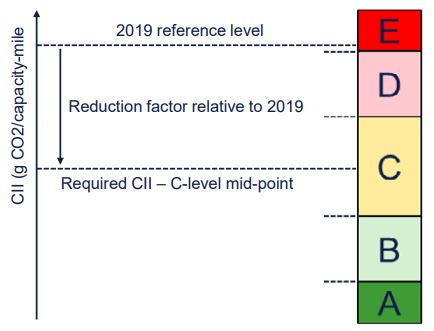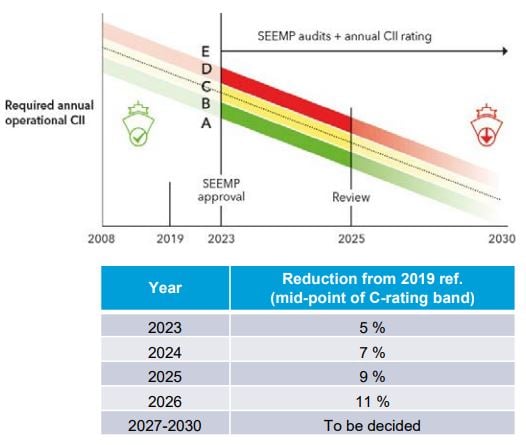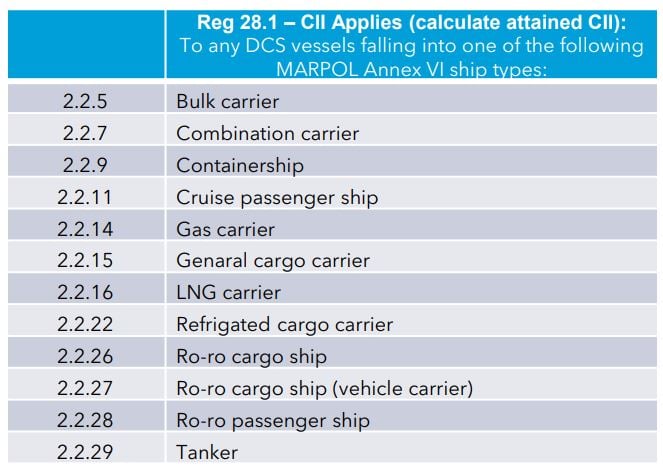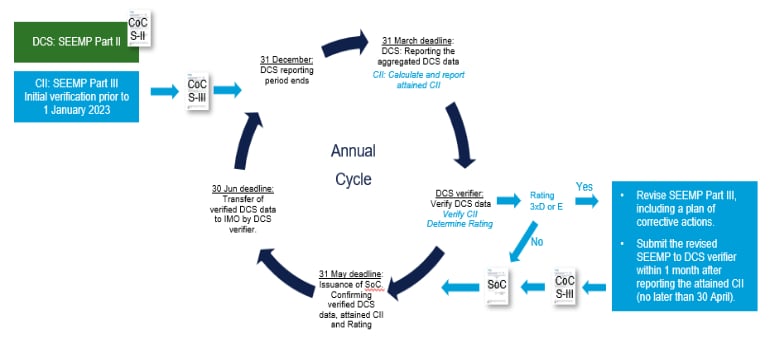SEEMP Part III and the upcoming SEEMP Generator from DNV
Since 2019 ships of 5,000 GT and above have been reporting their fuel oil consumption data mandated by the IMO DCS. From 2023, cargo, cruise and RoPax ships must calculate CII with a required rating of C or better. This means some ships will have to improve their carbon intensity. A verified Ship Operational Carbon Intensity Plan, or SEEMP Part III, is to be kept on board from 1 January 2023 to document how you plan to achieve your CII targets. This statutory news provides an update on the SEEMP Part III and recommends next steps.
Relevant for ship owners and managers as well as flag states.
The Carbon Intensity Indicator (CII) and operational carbon intensity rating
The attained CII is the CO2 emitted per capacity transport work during a calendar year, adjusted by correction factors (to be finalized at MEPC 78 in June) that will be available for some ship types and operations.

The CII will apply to the MARPOL ship types above 5,000 GT, as per Appendix 1. Based on its attained CII, a vessel will be rated annually from A to E, where A is the best and C the minimum rating. The required CII defines the middle point of the rating level C, and the boundary values for each rating are based on historical emission data for 2019 for the given ship type.

The rating system will be the primary mechanism to achieve the IMO’s ambition to gradually reduce the carbon intensity of international shipping to at least 40% by 2030 relative to 2008. The required CII, and thereby the rating thresholds, will be reduced year-by-year. The reduction rates are set for 2023 to 2026, and subsequent reduction factors will be set during a review in 2025.

The SEEMP Part III – purpose
The SEEMP Part III, or Ship Operational Carbon Intensity Plan, will serve as the implementation plan for achieving the required CII and will be subject to verification and company audits. In addition to describing the methodology used for calculating the CII and how to report, the following must be included in the SEEMP III:
- The required CII for the next three years, calculated based on the individual vessel’s specifications
- A 3-year implementation plan documenting how the required CII will be achieved during the next three years, with yearly targets
- Procedures for self-evaluation and improvement
- Corrective action plan in case of inferior rating.
The SEEMP Part III will be a dynamic plan, as it will be subject to regular updates and revisions. When making the plan, it is therefore important to keep in mind the objective of the plan and to make it fit for purpose.
Upon adoption of the IMO guidelines in June 2022, DNV will launch a SEEMP Part III Generator. The generator will be an online tool, reducing your paperwork and efforts, and can be used by both ship managers and third-party consultants working on behalf of DNV DCS customers.
It should also be noted that the new SEEMP III comes in addition to the SEEMP I and SEEMP II and will be handled as a separate document.
- SEEMP Part I (2013) – Ship management plan to improve energy efficiency, applying to all ships of 400 GT or above. Content is not subject to verification.
- SEEMP Part II (2019) – Ship fuel oil consumption data collection plan (DCS), applying to all ships of 5,000 GT and above. Subject to verification by a DCS verifier.
- SEEMP Part III (2023) – Ship Operational Carbon Intensity Plan, applying to ships of 5,000 GT and above (ship types as in Appendix 1). Subject to verification by a DCS verifier.
DNV’s SEEMP III Generator will reduce your workload, saving time and money
There are several good reasons for choosing the DNV SEEMP III Generator:
- Use of the SEEMP III Generator is free of charge for DNV’s DCS customers
- Working platform for carbon intensity management
- Fleet status overview
- A more effective and smoother verification, easy to update (online) and submit revisions for verification. The SEEMP III plan will be subject to updates at least every three years and in many cases more often, such as in the case of inferior ratings or modifications to the three-year implementation plan. In this respect, the DNV SEEMP III Generator will ensure a smooth update and verification process.
- Continuous emission monitoring will be key to ensuring that you are on track in terms of energy efficiency according to your plan. This is provided through DNV Emissions Insights under My Services on Veracity.
The CII and SEEMP III verification process, timeline
The first DCS reporting year for which a CII will be calculated is 2023, and the first rating will be given in the first half of 2024 based on the 2023 reporting year. Then, the first milestone when a verified SEEMP III shall be on board is 1 January 2023. The SEEMP guidelines are still under development and subject to adoption at MEPC 78 in June. This leaves no more than half a year to draw up, verify and implement the SEEMP III; hence, the timely launch of the DNV SEEMP III Generator in June 2022.
In the meantime, as a first step it may be convenient to identify the CII status by visiting Emissions Insights and to start considering potential measures, including the possible impact of EEXI measures if relevant. SEEMP III will also be listed in our Compliance Planner post-MEPC 78 in June.
The CII and rating follow the existing DCS verification cycle, and both will be noted on the Statement of Compliance (SoC) issued annually by the DCS verifier confirming the verification of the DCS data for the previous calendar year. The new title of the SoC will be Statement of Compliance – Fuel Oil Consumption Reporting and Operational Carbon Intensity Rating. For the SEEMP III, a new Confirmation of Compliance (CoC) will be issued upon verification, which will be in addition to the Confirmation of Compliance for the SEEMP II:
- From 2024, the CII must be calculated (recommended: DNV’s Emission Insights) and reported to the DCS verifier together with the aggregated DCS data for the previous year prior to 1 April, including any correction factors and voyage adjustments.
- The CII will be verified together with the aggregated DCS data.
- The SoC will be issued prior to 1 June as per today; the only difference is that the attained CII and the rating will be noted, and it will be required to keep the SoC on board for five years.
- In case of an inferior rating, meaning a D rating for three consecutive years or one E rating, the SEEMP III must be updated with a corrective action plan and verified before the SoC is issued. The corrective action plan should consist of an analysis of why the required CII was not achieved and include a revised implementation plan.
Recommendations
If DNV is your DCS verifier, we recommend using the DNV SEEMP III Generator, which will be available in June. In case you are using a third-party consultant to generate your SEEMP III, please let us know and we will provide access to the generator to enable the SEEMP to fit our platform.
Until the adoption of the IMO guidelines at MEPC 78 in June 2022, and the launch of the DNV SEEMP III Generator, we recommend that our customers start checking the status of their CII rating today and identify possible measures that may be implemented to achieve the target rating for the next three years. Please visit Emissions Insights under My Services in Veracity for an overview of the status and the impact on future ratings for your ships.
References
- DNV on DCS, MRV and Emissions Insights
- DNV on decarbonization in shipping
- DNV’s CII topic page
- Heads-up on EU MRV and IMO DCS in 2022
- Compliance Planner
Contact
- For customers:
DATE - Direct Access to Technical Experts via My Services on Veracity. - Otherwise:
Use our office locator to find the nearest DNV office.
Appendix
List of ships included in the CII regulations:


